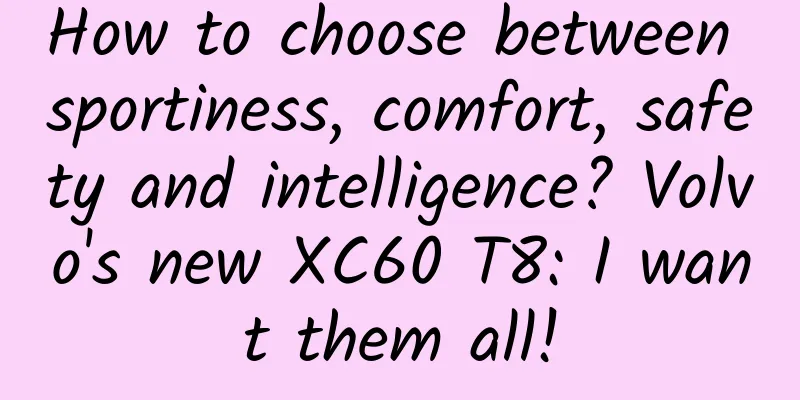How to choose between sportiness, comfort, safety and intelligence? Volvo's new XC60 T8: I want them all!

|
Traditional car companies have sounded the clarion call to move toward intelligence and electrification. When it comes to the intelligence and electrification of automobiles, everyone will definitely think of a number of new car-making forces first, while traditional car companies are often labeled as being unenterprising and lagging behind the times. However, the reason why this has become a consensus in online public opinion is largely because new energy vehicle companies have a greater publicity voice on the Internet. In fact, traditional car companies are also very aggressive in their plans for electrification, and they started their layout for intelligence even earlier. You can say that traditional car companies are more conservative about driving safety, but it is hard to say that they are behind the times. Volvo is such a brand. As a European car company with a history of nearly 100 years, Volvo, which is well-known for its environmental protection and safety, actually invested in automobile intelligence and automation very early. Volvo conducted autonomous driving tests in Europe in 2013, and drove safely for 1,200 kilometers on the West Sixth Ring Road in Beijing in 2015. Now Volvo's mid-term facelifted XC60 has been launched, taking another step forward in the electrification process, with the entire new model series becoming hybrid. In addition, this model has also made a lot of innovations in driving experience, human-machine interaction, and safety. While bringing a drastic reform product, it also depicts Volvo's blueprint for the future of the automotive industry. Low-key luxury, classic designIn terms of appearance, the new model follows the family design language of the series, with a lot of adjustments made to the details, but the overall changes are not significant. For example, a black vertical bar has been added in the middle of the straight waterfall-style chrome trim, making the front look more three-dimensional; the exhaust pipe has been changed to a hidden design, making it look more "electric". In terms of interior, while creating a sense of luxury in workmanship and materials, it still maintains the past Nordic minimalist style with simple lines and concise elements. Here I will briefly mention the difference in appearance between the sports model and the luxury model in this mid-term facelift. The most obvious part is the grille. The sports model uses a dot matrix grille, and together with the rearview mirrors and window trims, it uses a black sports kit, making it more youthful. In terms of interior, the sports model has brushed aluminum trim, the luxury model uses wooden trim, the sports model gear lever is wrapped in leather, and the luxury model uses the Oris crystal gear lever for the entire series. Speaking of Oris, we know that it is an internationally renowned crystal brand as famous as Swarovski. Like Volvo, it comes from Sweden and is also the designated crystal tableware provider for the royal family at the Nobel Prize dinner. A set of tableware alone costs nearly 5,000 yuan. They are usually reluctant to use it and are locked in the safe in the city hall. Think about the Oris crystal that even the Swedish royal family is reluctant to use, but the owners of Volvo XC60 can hold it in their hands every day while driving. What a show (tactical leaning back). Not only the crystal gear lever has been introduced to more subdivided models, this time the new Volvo XC60 has smoothed out a lot of configuration differences. For example, the 12.3-inch full LCD instrument panel, electronic gear lever, hybrid, 8-speed automatic transmission, sixth-generation BorgWarner four-wheel drive system and other configurations have become standard for the entire series in the mid-term facelift, which is full of sincerity. Powerful energy saving, combining performance and economyBefore talking about the dynamics, let me first explain that the car tested is the Volvo XC60 Recharge T8 plug-in hybrid four-wheel drive Zhiya Luxury Edition, which is the top of the series and has an official retail price of 603,900 yuan. The T8 version is equipped with a turbocharged, mechanical twin-supercharged front-wheel drive engine with a maximum power of 303 horsepower and a maximum torque of 400 Nm. It is also equipped with an 11.6-degree battery and a rear axle motor, with a maximum power of 87 horsepower and a maximum torque of 240 Nm, and can travel 50 kilometers on pure electricity. If there is a convenient charging station at home, the electricity consumption can basically cope with daily commuting in the city. Of course, the motor can also cooperate with the engine to achieve more powerful performance. The system has a maximum comprehensive power of 390 horsepower, a maximum torque of 640 Nm, and an acceleration time of 0 to 100 kilometers in 5.5 seconds, which is very powerful. The official comprehensive operating fuel consumption is 2.1L per 100 kilometers. After a series of intensive tests, the fuel consumption is only 4L, which is an excellent performance in terms of fuel economy. Especially considering its positioning as a mid-size SUV and its curb weight of nearly two and a half tons, although owners of the Volvo XC60 are unlikely to be very sensitive to the cost of using the car, this does reflect Volvo's original intention of plug-in hybrid technology to "go on the field, that is, at home." The T8 model supports five driving modes: hybrid, sports, pure electric, off-road, and all-wheel drive. Daily use of the hybrid mode can bring an excellent driving experience. The engine and motor work closely together to bring a smooth and smooth acceleration experience. Relying on the advantage of low torque, the motor undertakes most of the work at low speeds; at high speeds where the engine performs better, the engine's intervention is also very smooth. As the accelerator is pressed, the engine will cooperate with the motor to provide very linear power output. In sports mode, the engine intervenes more actively and the power curve is steeper. The 0-100 acceleration in 5.5 seconds makes every overtaking easy. The excellent fuel consumption performance also comes from the advanced battery strategy. In addition to plugging in, the battery of the XC60 T8 also supports kinetic energy recovery and fuel charging. When the battery is low, the XC60 can charge the battery as a generator within the engine's optimal thermal efficiency range, providing a range extension function and avoiding the engine working at low speeds. This is undoubtedly the source of the Volvo XC60 T8's high fuel economy. In addition, while maintaining high performance and low fuel consumption, the Volvo XC60 does not compromise on comfort. The 4C adaptive chassis can scan and monitor the road surface 500 times per second, and adjust the four-wheel power distribution of the air suspension height in real time. After actual experience, I think the Volvo XC60 is very well tuned. It filters small potholes on the road well and can handle large drops appropriately. The bumps transmitted to the cabin are relatively gentle. When dealing with continuous bumpy roads or speed bumps, the bounce suppression is also excellent. The overall heavy feeling of the chassis highlights the taste of a luxury car. Smart security, smart upgradeOf course, the last thing we have to mention is the intelligence of Volvo XC60, which is also the key upgrade point of the new model. In addition to the LCD instrument panel that comes standard on all models, Volvo is also the world's first car company to jointly develop a car system with Google. The XC60 is also the world's only model with a built-in native Android automotive-grade system, and it performs well in navigation, entertainment, voice, and applications. The Volvo XC60's car computer also has a built-in Huawei App Market, providing powerful scalability. After testing, it was found that Xiaowo, a voice assistant with technical support provided by iFlytek, not only has a very high voice recognition rate, but can also make semantic inferences through association and analysis, and understand the hidden meaning of the car owner. In addition, Xiaowo's microphone is also equipped with a directional function, which only receives voice commands from the driver's seat, effectively preventing false wake-ups. Volvo also very down-to-earth launched a dream collaboration with Tmall Genie, completely connecting the two spatial scenes of home and car. Users can not only control the air conditioning in their car at home before traveling, but also turn on the air conditioning and water heater at home from the car before arriving home, fully demonstrating the charm of the Internet of Vehicles. In addition, although rarely mentioned by the media and car owners, the Volvo XC60's PA Pilot Assist navigation assistance system actually has a high degree of completion. As mentioned earlier, Volvo itself started its intelligent layout very early. However, because it concerns driving safety, traditional car companies still adopt a practical and conservative attitude towards assisted driving systems, which also leads to many traditional car companies not getting the exposure they deserve in the public opinion level. Because of this, the assisted driving functions installed by Volvo are very practical and run very stably. For example, the adaptive cruise control function, whose start and control buttons are placed on the left side of the steering wheel, can smoothly help users keep the car body in the center of the lane without bouncing between lane lines. Even large-angle turns can be recognized and operated normally. The plus and minus keys on the steering wheel can be used to adjust the speed, and the horizontal key can help the vehicle set the distance from the vehicle in front. The XC60 can drive at a set speed, and if the vehicle in front is driving below the speed limit, the vehicle will automatically follow the vehicle in front at the set distance. When the car in front brakes, the Volvo XC60's adaptive cruise control can also brake at a comfortable force, instead of frequent sudden braking like many other models, which can make passengers want to vomit. Of course, this also comes from Volvo's confidence in its technology, because the XC60 is the first domestically produced model equipped with Continental's electronic brakes. The braking response time only takes 0.15 seconds, which is twice as fast as traditional brakes. The advanced point of Volvo XC60's PA is that after you manually turn the steering wheel to change lanes, the PA system will automatically resume after driving smoothly. There is no need to manually turn on the PA frequently, which is actually very practical. In addition, the adaptive cruise control will remind you to shake the steering wheel every once in a while to prove to the system that you are still paying attention to the road conditions. The steering wheel sensor of the Volvo XC60 is obviously more sensitive. The driver only needs to touch the steering wheel lightly, unlike some brands of assisted driving systems that require strong steering and the wheels start to shake before they can be recognized, which becomes another form of safety hazard. Speaking of safety, this is also one of the most profound brand images that Volvo leaves on users. Many people on the Internet say that when Volvo is mentioned, it is said to be safe. Doesn’t it have any other selling points? Here, I would like to ask a question: For a mechanical behemoth that weighs more than two tons and carries the lives of your family, what is more important than safety? There is no doubt that Volvo is the car company that attaches the most importance to driving safety. This should not be considered a violation of the Advertising Law, right? Many of the safety features that are commonplace today were first introduced to the automotive industry by Volvo, such as laminated glass, airbags, rear-facing safety seats, blind spot monitoring systems, etc. The three-point seat belt used in every car today was invented by Volvo in 1959. It has saved millions of lives so far, and Volvo then shared the patent for the seat belt with all manufacturers free of charge. Therefore, it is easy to tell whether a car company is using safety as a gimmick or really cares about the safety of car owners. Another widely used invention of Volvo is the cage structure of the car. Playing stacking games with cars has also become a kind of Volvo tradition. Recently, Volvo asked Yuan Xiaolin, global senior vice president, president and CEO of Asia Pacific, to sit in the lowest car and play a game of Jenga. Afterwards, the media asked him if he was afraid. He said yes, I was afraid that other brands would not imitate well and something would go wrong… This can be regarded as Volvo's own demonstration of what "do not imitate dangerous actions" means. This experiment was very popular on Zhihu at the time, but in fact, besides being interesting, it was also a very rigorous compression test. After stacking the cars for 24 hours, the car was dismantled to measure the structural deformation. Volvo's compression strength can indeed be called black technology. Of course, powerful intelligent technology is now also used by Volvo to achieve higher levels of safety. Volvo invented the city safety system called Cite Safety in 2008, which uses active braking to avoid collision accidents. The Volvo XC60 now has 20 high-sensitivity sensors all over its body. The front high-precision camera has a detection angle of more than 100 degrees; the millimeter-wave radar has a maximum detection angle of 140 degrees and a maximum detection range of 180 meters; the high-speed data transmission bus adopts a double insurance line design, and the transmission rate is 20 times higher than in the past. These configurations have become the cornerstone of Volvo's safe and intelligent driving. Emergency avoidance assist, oncoming vehicle avoidance, automatic braking at intersections, blind spot information system, etc., make the Volvo XC60 have the most comprehensive active safety system on the market. Some of these functions are quite useful in daily driving. For example, if you change lanes without using the turn signal at high speed, the system will use a slight steering wheel to assist the vehicle back to the original lane. This is also a disguised reminder to the driver that although there is lane change assistance, the turn signal is still required to change lanes. (Data from Dongchedi) In summary, the advancement of Volvo's intelligent safety system is obvious to all. In fact, many media on the Internet have conducted comparative evaluations of active safety systems, and Volvo has basically topped the list without exception, proving that traditional car companies are not incapable of using sensors and intelligent algorithms. Furthermore, Volvo is no longer focusing on the intelligence and safety of individual vehicles. Relying on a wealth of sensors and road data, Volvo is actively promoting the popularization of slippery road warning systems in the industry. When a car encounters dangerous road conditions, it will be able to push danger warnings to nearby vehicles through cloud interconnection, using the Internet of Vehicles to create a safe travel network. At a time when vehicle-road collaboration is being actively promoted, the data interoperability between vehicles proposed by Volvo provides a new way of thinking. With the popularization of smart cars, once the exponentially increased driving data can be interconnected, it will inevitably push autonomous driving and safe driving to new heights. SummarizeTraditional car companies tend to be pragmatic when it comes to assisted driving systems, not because they are conservative, but because they have a deeper understanding of the automotive industry and have more respect for user life safety. When it comes to autonomous driving technology, Volvo is strategically aggressive. Not only has it already started an exclusive partnership with Waymo, a pioneer in autonomous driving technology, but it also announced its partnership with travel company Didi at the XC60 launch conference, opening up the connection between technology and data. It is reported that in the next generation of models, Volvo will work with Silicon Valley's top technology Luminar to take the lead in mass-producing 300-line automotive-grade laser radars, which will be able to achieve L4 level autonomous driving even in dense fog. Let’s talk about the protagonist of this article, Volvo XC60. As a European car manufacturer, it is undeniable that Volvo’s brand power is slightly inferior to that of BBA, but in terms of intelligence and electrification, Volvo XC60 is half a body ahead. Data shows that Volvo's sales hit a record in the second half of 2020, and one-third of them came from rechargeable cars. In the first five months of this year, Volvo's cumulative sales in the mainland market reached 78,343 units, a year-on-year increase of 55.3%. At this point in time, the world's most popular new XC60 series products are launched. In addition to maintaining the usual sense of luxury and safety, the T8 version of the plug-in hybrid model also finds a near-perfect balance between performance and comfort. The new native Android car regulation system, in cooperation with iFlytek and Tmall Genie, takes into account the scene interaction between people and cars, and cars and homes. It uses cars to connect homes, travel and scenes. It also uses the concepts of cloud interconnection and vehicle networking to bring the concept of driving data interoperability, showing us the future of the Internet of Things with cars as an important part. The Volvo XC60 Recharge T8 plug-in hybrid model is not only a summary of the era of fuel vehicles, but also a look into the era of electrification and intelligence. I believe that this mid-term facelift will continue its century-old legend in terms of sales and user reputation. As a winner of Toutiao's Qingyun Plan and Baijiahao's Bai+ Plan, the 2019 Baidu Digital Author of the Year, the Baijiahao's Most Popular Author in the Technology Field, the 2019 Sogou Technology and Culture Author, and the 2021 Baijiahao Quarterly Influential Creator, he has won many awards, including the 2013 Sohu Best Industry Media Person, the 2015 China New Media Entrepreneurship Competition Beijing Third Place, the 2015 Guangmang Experience Award, the 2015 China New Media Entrepreneurship Competition Finals Third Place, and the 2018 Baidu Dynamic Annual Powerful Celebrity. |
<<: Hisense will launch OLED TV and color TV competition will enter the high-end era
Recommend
Are German cars more durable than Japanese cars? Media tested the Volkswagen Sagitar against the Corolla. Who lost again?
There is a saying among car enthusiasts that Germ...
Apple can’t escape the law of true fragrance: iOS 16 will be embedded with a large number of advertisements, will you buy it?
I once saw someone say in a forum: The only reaso...
Do you remember all these things Apple did during Cook's era?
In August 2011, Steve Jobs, then CEO of Apple, an...
Xiaomi Vice President: Open-sourcing Android is the smartest decision Google has made
[[140858]] Xiaomi Vice President Hugo Barra was G...
One article will clarify the product’s pain points, itching points, and selling points!
What does marketing rely on to start? In the fiel...
Neural network basics: seven network units, four layer connection methods
In September 2016, Fjodor Van Veen wrote an artic...
How much does it cost to join a course and purchase a mini program in Fangchenggang?
Why join the WeChat Mini Program Development Comp...
The reason why Android is lagging more than iOS has been found: it uses nearly 3 times more memory
When we mention Android and iOS, many people'...
Nanjing suspends on-site tomb sweeping during the 2020 Qingming Festival! What should we do if on-site tomb sweeping is suspended? You can pay respects to the deceased in this way!
As the Qingming Festival is approaching, many fri...
App facing difficulties? ! Let’s gamify your product
As a typical representative of Internet products,...
How to build your own traffic circulation system?
Before I start sharing how to build a traffic cir...
"One Piece: Journey" lead programmer Dan Bei Leng: We want to become the team of the game king
"One Piece: Thousand Voyages" built on ...
NetEase Cloud Music Product Analysis: The Product Logic Behind the Drastic Increase in Data
NetEase Cloud Music was launched in April 2013, a...
How to optimize English websites, Google English optimization suggestions
Optimizing an English site is much more difficult...
Datong Flowers Mini Program Agent Price Query, Datong Flowers Mini Program Agent Price How much is it?
Why should you be an agent for WeChat Mini Progra...









